If I could count the number of times that someone said they hated brussels sprouts as a kid, but love the nutty little nuggets today, I’d be a rich woman.
Do you know who else loves brussels sprouts? Bugs.
Caterpillars, worms, and little sap-sucking insects of all kinds can’t seem to get enough of cole crops in general.
The good news is that brussels sprouts have the advantage of growing big, attractive leaves that we humans don’t usually use. Insects often attack this foliage first.
In most cases, it doesn’t matter much if you see some cosmetic damage to the foliage, so long as the heads are not impacted.
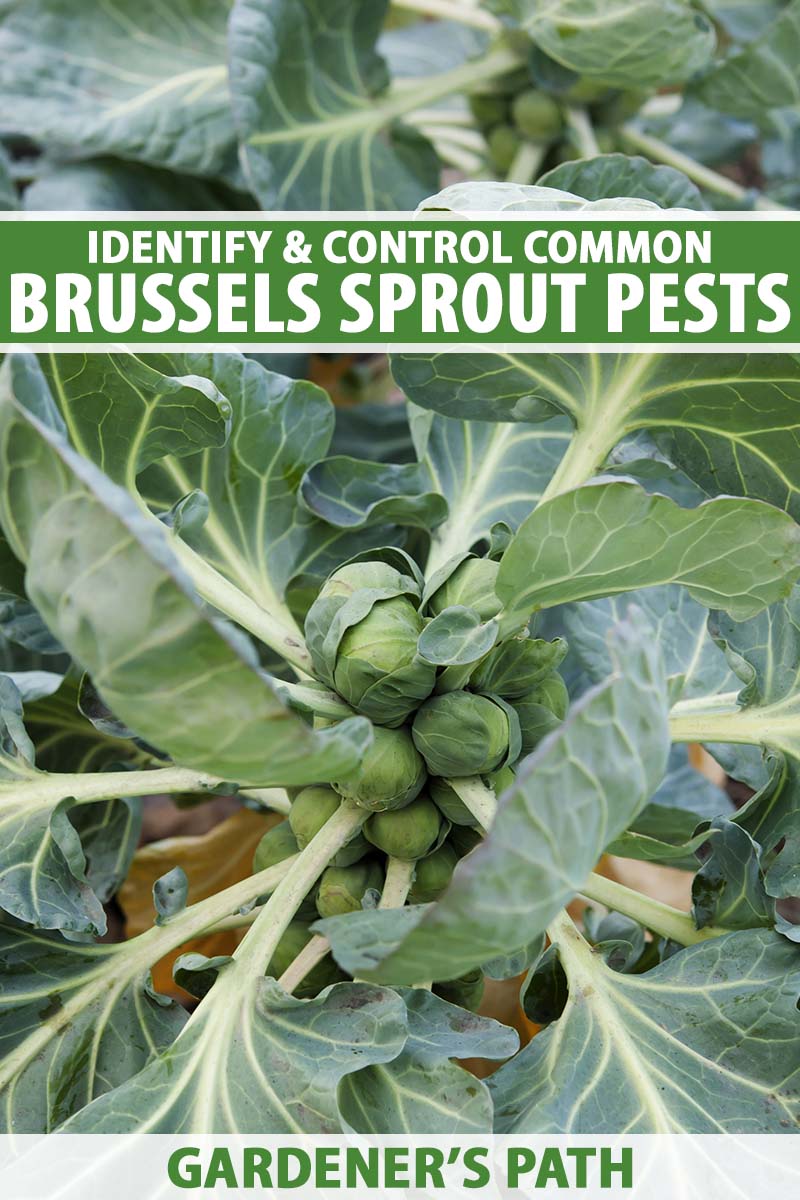
We link to vendors to help you find relevant products. If you buy from one of our links, we may earn a commission.
That said, some pests can spread or invite disease, no matter where they attack.
Some might not bother the heads, but the damage they cause can prevent sprouts from forming, or any sprouts that form might be stunted, ugly, or even loose.
This guide will help you figure out what’s eating your plants (besides you, of course), when to take action, and what you need to do to protect your precious sprouts.
Here’s what we’ll discuss:
What You’ll Learn
Best Practices to Avoid Pests
Every pest is different, but there are things you can do to discourage invertebrates from attacking your plants.
Brussels sprouts are part of the cabbage family (Brassicaceae). That means they’re susceptible to attack from any insect that prefers brassicas.
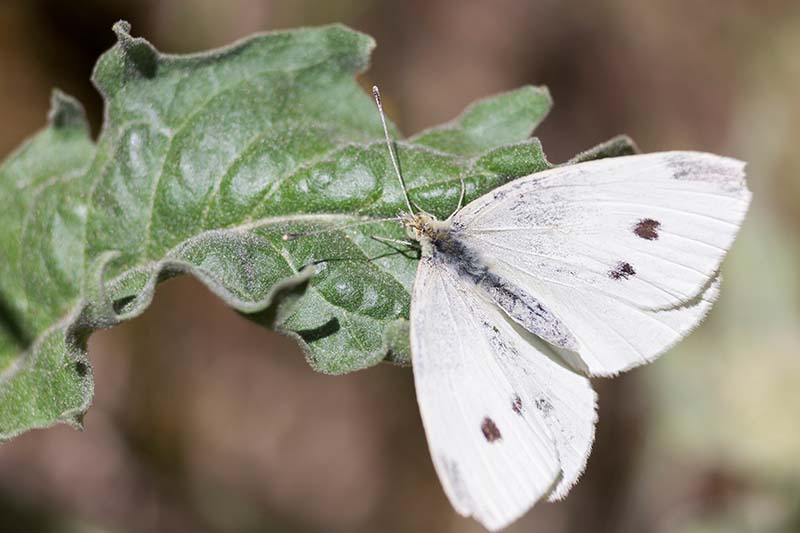
To avoid these insects in the garden, there are a few steps you can take.
First, crop rotation is always a good idea. Many pests overwinter in the soil and wait for spring to attack.
If you don’t put something they like or can obtain nutrition from in the vicinity, they won’t have anything to eat and they’ll die off.

Interplanting is also smart. This involves putting plants from different families next to each other. This can also make it harder for predators to identify the plants they like to target.
Instead of planting 20 square feet of brussels sprouts, you could plant one next to something in a different family, such as a nightshade.
They don’t share many pests, so something that likes to nibble on new potatoes usually won’t be interested in nearby sprouts.
Remove weeds and debris from the garden to deny pests alternate hosts or a place to hide.
13 Common Brussels Sprout Pests
If insects are irritating your brussels sprouts, there’s no time to lose, so let’s not wait a minute more!
Here are 13 of the most common pests, and how to deal with them:
1. Aphids
It’s a fact of life that if you garden, you WILL deal with aphids at some point.
Honestly, they’re so common that I pretty much ignore them unless it starts to look like my garden is more aphid than plant (okay, that’s a slight exaggeration…).
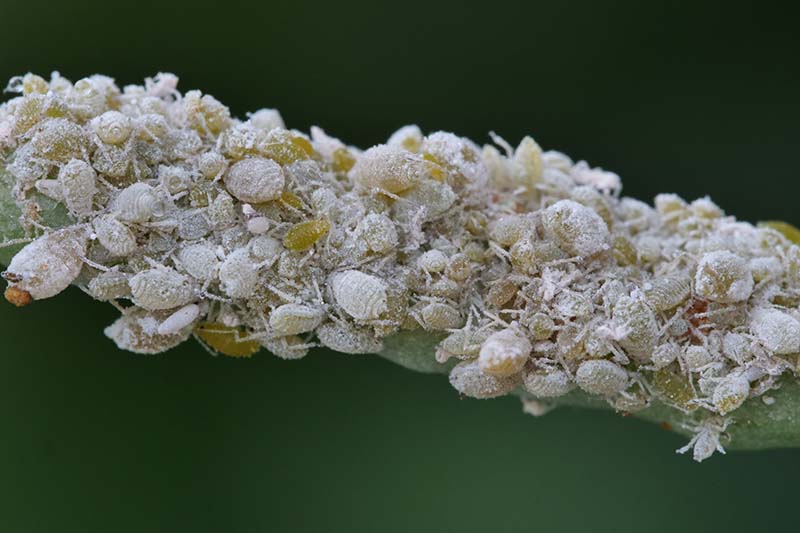
Plus, aphids attract beneficial insects that will eat all kinds of even worse bugs. So there’s that.
On the downside, aphids can spread diseases, and they just generally suck because they reproduce quickly and drain your plants’ energy. If they weaken your plant, it becomes susceptible to all kinds of other pests and diseases.
The kinds of aphids that will attack brussels sprouts are known as Brevicoryne brassicae.
They can be dealt with in the same way as any common aphid. Our guide can walk you through it all.
2. Armyworms
Armyworms are related to cutworms, but the damage that they do is very different.
Brussels sprouts may be attacked by three different types of these worms, which are the larvae of certain night-flying moths.
These are the beet armyworm (Spodoptera exigua), the Bertha armyworm (Mamestra configurata), and the Western yellow-striped armyworm (S. praefica).
They can vary in appearance from solid to striped or spotted, in colors ranging from light yellow to nearly black. All are around an inch long.

The worms can burrow into the buds or heads and can skeletonize leaves. What makes them particularly irritating is that they tend to come in waves.
For a year or two you will hardly see any. It’s almost like they’re waiting for you to let your guard down. Then, one year it’s like an invading army of worms have breached your garden’s fortifications and taken over.
Weed control is important. There are many “weeds” out there that may act as host plants, including Russian thistle, purslane, mullein, lamb’s-quarter, wild mustard, and pigweed.
If you see them, pluck them off and drown them in soapy water.
If you’re experiencing one of those intense years, Bacillus thuringiensis v. kurstaki (Btk) is going to be your best friend. We talk a bit more about this beneficial bacteria below.
Neem oil or insecticidal soaps are also effective, but they need to be reapplied often to make direct contact with the worms.
Try alternating your treatments each year to improve effectiveness, and prevent the development of resistance.
These little caterpillars have lots of natural enemies including spiders, assassin bugs, damsel bugs, and minute pirate bugs.
Did you know that if you don’t have these beneficial bugs in your garden already, you can often buy and introduce them? Places like Arbico Organics carry live bugs in packs of 500, 1,000, or 2,000.
Insecticides containing spinosad or pyrethrins can also help, but leave the option to use these as a last resort.
3. Cabbage Loopers
Cabbage loopers (Trichoplusia ni) are inch-long green caterpillars that have a knack for making brussels sprout leaves look more like lace than foliage.
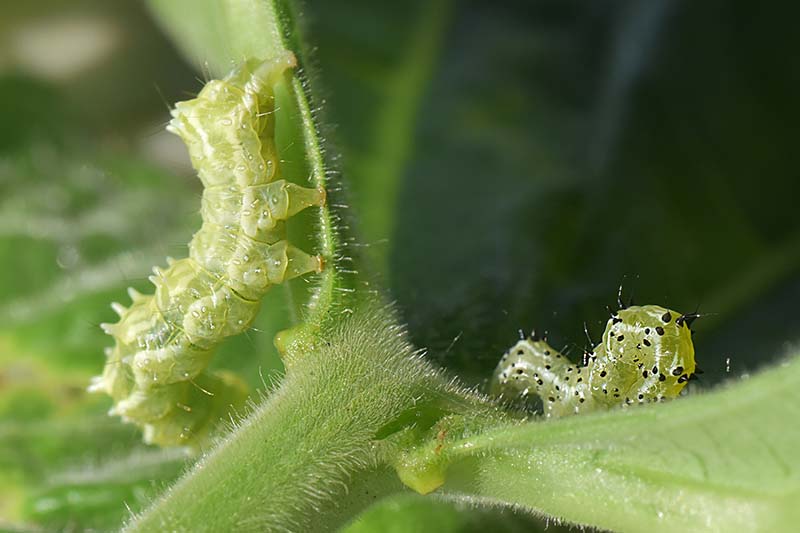
They’re extremely common across North America and they can have multiple generations each year, so chances are you’ll bump up against them sooner or later if you’re growing brassicas.
When that happens, take a look at our guide on how to identify and eliminate loopers.
4. Cabbage Whites
I remember watching cabbage white butterflies dancing around the plants in my backyard when I was a kid and thinking they were like beautiful flying flowers that signaled the height of summer.
Then I started growing brassicas, and while I still think they’re pretty, I’m not so excited to see them anymore.

Fortunately, these aren’t a big problem on brussels sprouts because they tend to be most active during the summer. However, they can still show up in spring and fall crops, so it’s best to keep an eye out.
The adult moth (Pieris rapae), which is white with dark brown or black spots on the wings, isn’t the troublemaker. It’s the larvae that you want to avoid, which are small green worms called imported cabbage worms.
These little worms chew their way into the heads, where they stick around and feed.
They eat the leaves of the plant, too, though that’s mostly just a cosmetic issue. In large enough numbers, however, they can skeletonize the foliage.
If you don’t have too many, you can simply handpick them off your plants and drown them in soapy water.
Bacillus thuringiensis v. kurstaki (Btk) is also extremely effective against them, and many other types of worms and caterpillars as well.
There are multiple products on the market containing Btk, such as Bonide’s Thuricide.
Available at Arbico Organics in quart- or gallon-size ready-to-use containers or eight- or 16-ounce bottles of concentrate, simply spray every week or so when the moths are active.
5. Cutworms
If there’s one caterpillar out there that should make you nervous, it’s the cutworm. Some pests take weeks or months to damage your plants, but a cutworm can destroy your seedlings in just one evening.

Cutworms are the larvae of various night-flying moths in the family Noctuidae. They are most damaging to brussels sprouts when they’re seedlings because they chew through the base of the plants, killing them.
Once the stems grow thicker and become more mature, you don’t have to worry about this pest so much.
We have a comprehensive guide to help you figure out how to handle a cutworm situation.
6. Diamondback Moths
The larvae of diamondback moths (Plutella xylostella) may be tiny, but they’re voracious eaters.
On top of that, they feed at the base of sprout buds, damaging them to the point where sprouts fail to form. They can also devour young seedlings rapidly.
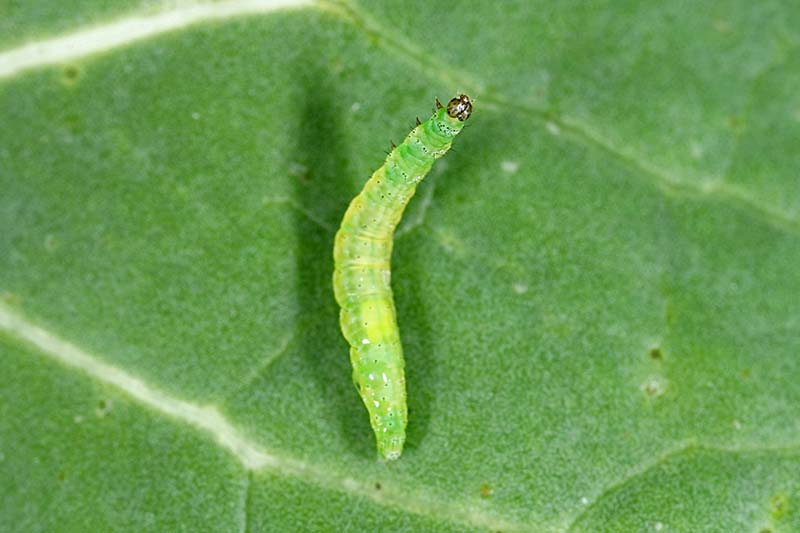
The caterpillars are green and just a third of an inch long. Some have two prolegs at the back that make a distinctive v-shape.
The adults are light and dark brown with, as you might have guessed, diamond-shaped markings on their wings.
If you spot the adults or the larvae, act quickly. Btk is effective against this pest, but you want to be sure to address the problem before they can do too much damage.
7. Earwigs
Pretty much everyone knows what an earwig looks like, with its distinctive pinchers on the rear end and its long, brown body.
There are many different species out there, and not all of them do damage to vegetable plants. Forficula auricularia is the one you need to watch for – and it’s one of the most common types.
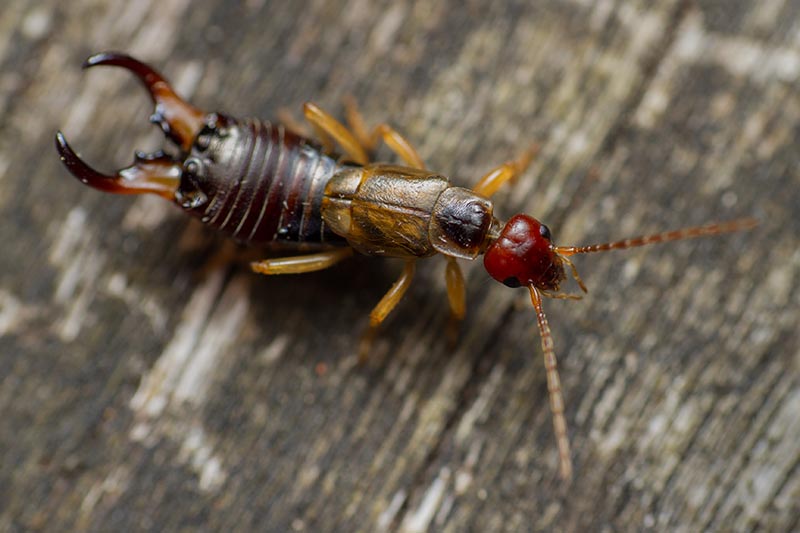
Regardless of the species, earwigs can have an overall positive impact in the garden, since they devour aphids and other unwelcome pests. That said, they can completely destroy a brussels sprout seedling in just a few days.
If you start your seedlings indoors, earwigs are nothing to be concerned about.
By the time you transplant, the sprouts will be large enough to withstand an attack. But if you plant seeds outside and you notice earwigs about, you’ll need to provide some protection.
Our guide to earwigs can help.
8. Flea Beetles
Flea beetles, which are little insects from the Chrysomelidae family, are fairly common pests. They can cause some pretty substantial damage even though they’re quite tiny.
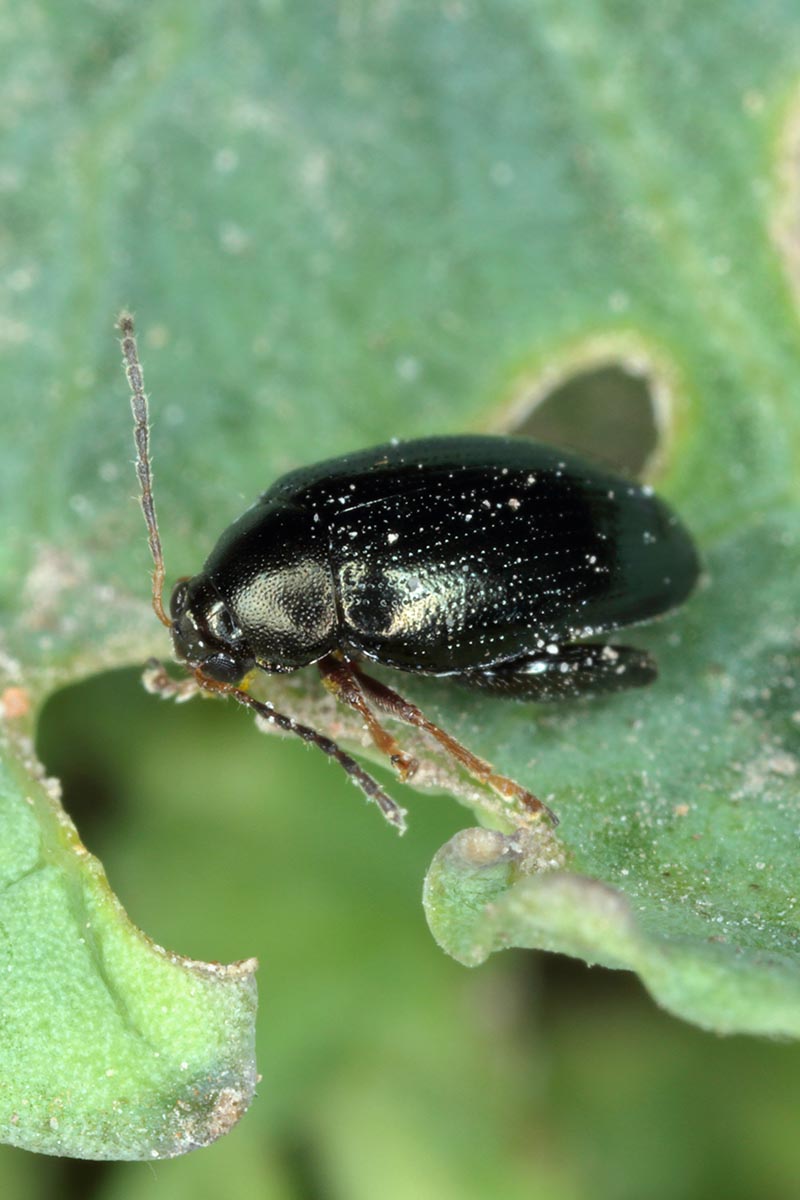
Because they’re so small, it can be hard to spot them, so it’s easiest to look for the damage they leave behind.
If flea beetles are feeding on your brussels sprouts, you’ll see tons of little shotholes nibbled throughout the lower foliage. They don’t typically bother the sprouts or younger leaves at the top.
While the damage is usually just cosmetic, which isn’t a big deal because it’s those sprout heads that we’re worried about, severe damage can stunt your plant’s growth.
Planting early or late in the year can help, as can planting trap crops, tilling, and using floating row covers.
To learn more about how to identify, prevent, and eliminate this pest, our comprehensive guide has all the details you need.
9. Leaf Miners
Leaf miners are the larvae of flies in the Liriomyza genus. These little worms chew tunnels through the leaves of various veggies and ornamentals, leaving their tell-tale maze-like trails behind.

The miners themselves aren’t anything to worry about when it comes to growing brussels sprouts. They do some cosmetic damage to the foliage, but they don’t harm the sprouts.
The problem is that both the adults and the larvae can spread disease, and the damage they leave behind is an invitation for fungal and bacterial diseases.
Anyone who grows brassicas knows that fungal diseases are to be avoided at all costs.
Your best bet, if you’ve dealt with these pests in the past, is to put floating row covers over your sprouts in the fall. Miner adults don’t lay eggs on plants in the spring.
If you already have leaf miners in the garden, don’t worry about trying to get rid of them. Just keep a close eye out for signs of disease.
For more details on how you can identify and prevent leaf miners, head on over to our guide.
10. Root-Knot Nematodes
Root-knot nematodes seem more like a disease than a pest, to be honest. That’s because you can’t see them.
They’re microscopic and they live in the soil, attacking the roots of your sprouts, and a whole host of other veggies, as well.
These roundworms from the Meloidogyne genus can cause serious damage, in both home gardens and commercial farm operations.
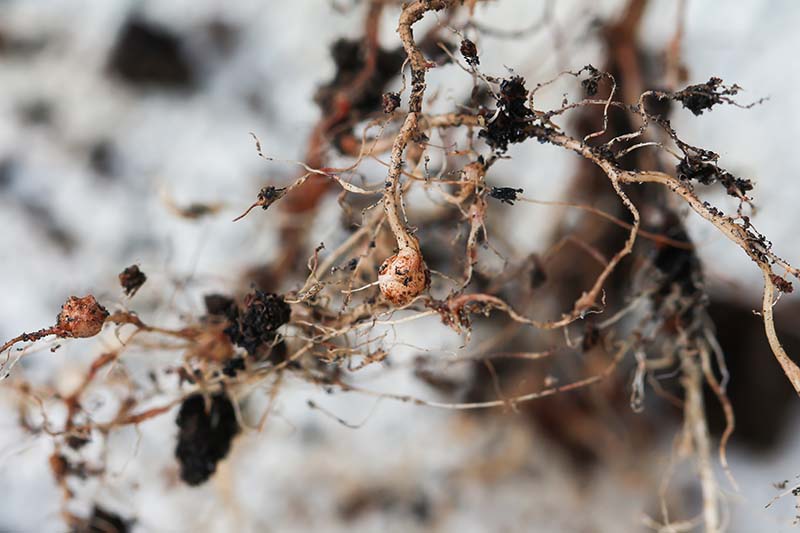
Root knot nematodes cause the roots of plants to become clubbed and malformed. But one of the worst things about this pest is that you can’t tell you even have an infestation until it’s too late to do much about it.
Above ground, the symptoms are a bit more vague in that they can resemble a number of other diseases. Sprout foliage may wilt or turn yellow, and the plants may be stunted. They may even die.
Once your sprouts are infested with root-knot nematodes, they’re toast. You can’t cure the problem without killing the plant.
You can let your infected crop keep growing and hope for the best, but it might be best to pull infested plants and treat the soil to avoid spreading these pests throughout your whole garden.
We have lots more details on the best way to determine if you have this problem and how to deal with it if you do in our guide to root-knot nematodes.
11. Snails and Slugs
My grandma used to pay me and my cousins a nickel for each snail or slug that we caught in the garden, and then we’d stick them all in a giant bucket and pour salt on them. Gruesome!
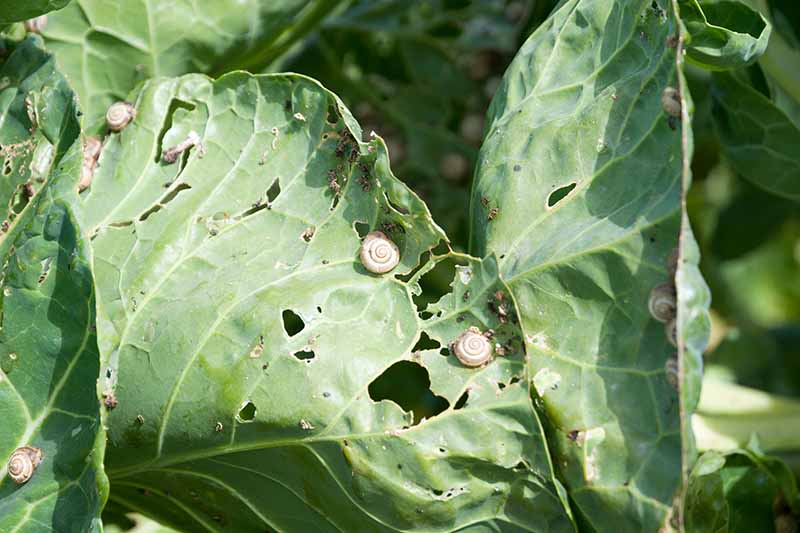
I always wondered why my grandma waged a vendetta against these creatures, which seemed to me like something out of a sweet fairytale involving fairies and talking rabbits. Then I had my own garden…
Once you begin having to deal with gastropods, you’ll have a lot less tolerance for them in your garden, too. That’s because they can devour an entire seedling in one night.
Older brussels sprouts plants are generally fine in the face of an infestation, since the slugs and snails tend to stick with the leaves and don’t bother the heads, but you still want to wrestle the situation into submission. Those holes in the foliage leave the plant open to certain diseases.
Head on over to our guide for tips on how to eliminate slugs and snails.
12. Thrips
Thrips in the garden can be good, or they can be really, really bad.
The good kind can help to take care of bad bugs in the garden, but the bad kind (Frankliniella occidentalis and Thrips tabaci) can cause yellow, silvery, or brown leaves that may or may not be distorted.
Heads can be distorted as well. With enough of them, the plant’s growth might even be stunted.
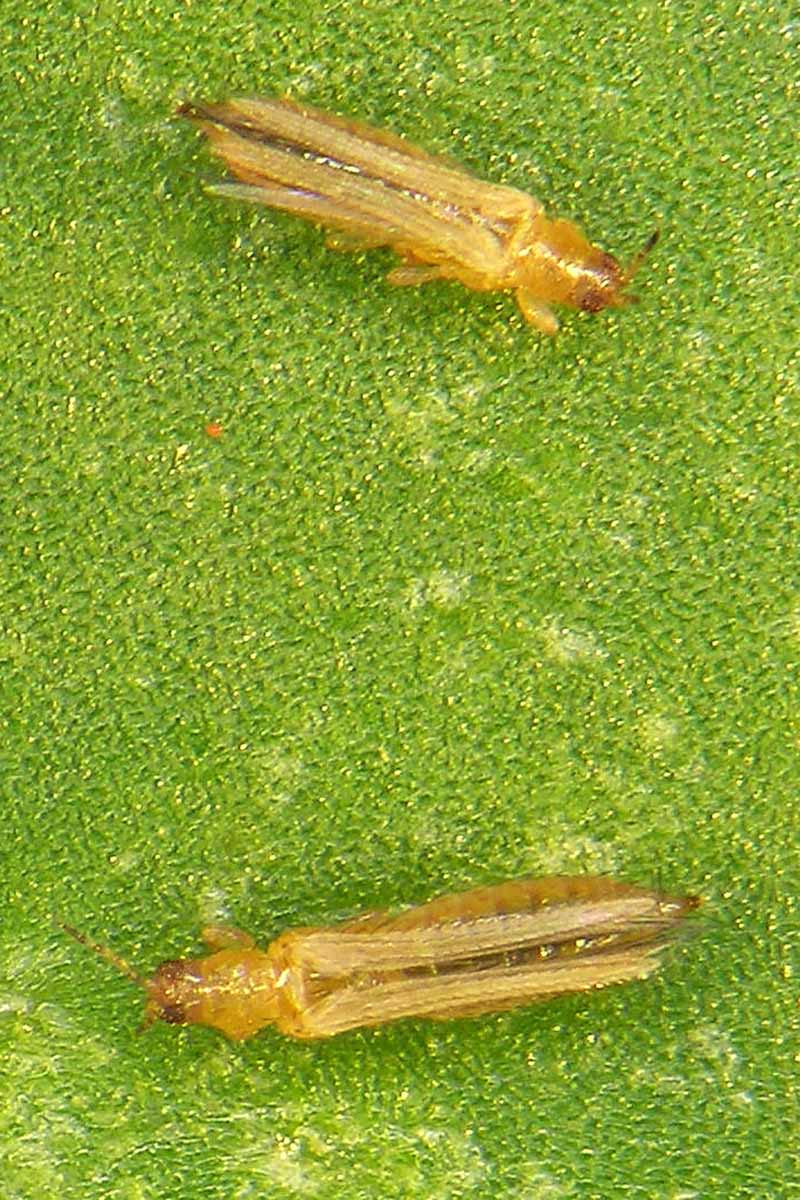
That’s not the end of it, either. They can spread all kinds of diseases, some of which can kill your plants and that have no cure, such as mosaic viruses.
They’re difficult to spot because they’re itty-bitty – one and a half millimeters long and extremely slender. Most gardeners notice the symptoms on their plants rather than the bugs.
Fortunately, there are a few things you can do to keep thrips away from your brussels sprouts.
First, don’t plant them next to cereals or anything in the Allium genus, including onions, garlic, and chives. These are the main targets of Western flower and onion thrips.
Reflective mulch can also be effective. Learn more in our guide to dealing with thrips in the garden.
13. Wireworms
As with many of these pests, wireworms are a threat to young plants, but older plants are generally immune.
So, what are wireworms? They’re the larvae of click beetles, which are insects in the Agriotes, Conoderus, Limonius, and Melanotus genera.
At a third of an inch to an inch long, these tan worms live in the soil and feed on the roots of brussels sprouts, which causes plants to be stunted and weak.
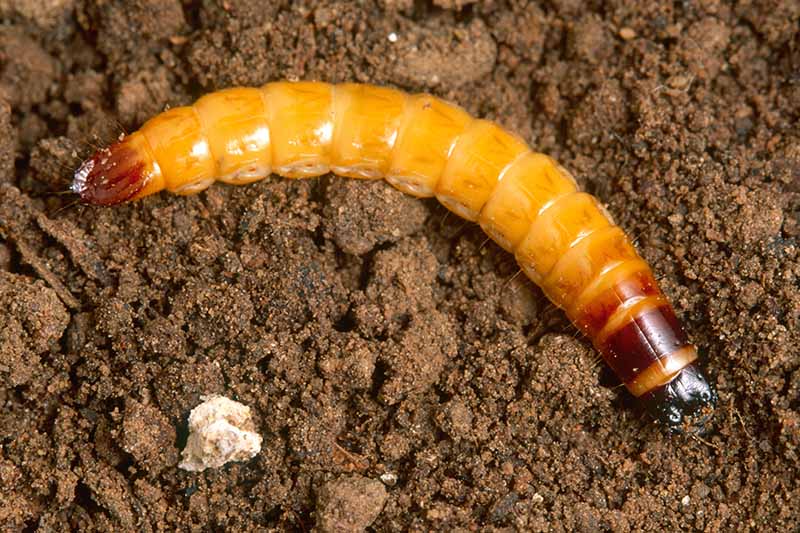
The good news is that they mostly attack in the late spring to late summer, so most sprouts are safe.
That said, you can’t totally let your guard down with the warm season creeping further into the spring and fall. They can be active any time air temperatures are over 50°F.
You need to be particularly vigilant if you’re growing near cereals or other grasses, including lawns.
These bugs can be a challenge to deal with.
The symptoms they cause can look a lot like those of many diseases, insecticides don’t work on existing infestations, and it can be hard to spot the bugs because they live underground for several years.
Setting out bait to see if wireworms are present before planting is smart.
You can buy bait, but it’s easy to make at home. Combine a cup of oats, a tablespoon of honey, and enough water to make it stick together in a compact ball but not feel mushy. You might need to increase the amount of liquid to a cup of water.
Dig a hole and cover the ball with an inch of soil. After a week, dig it up and crumble it apart to look for worms. If they’re present, let the soil in the planting area dry out thoroughly.
Then, use a pre-treatment insecticide containing pyrethrin. Or, add Steinernema carpocapsae, which are beneficial nematodes that attack wireworms, to the soil.
NemAttack Beneficial Nematodes
You can purchase these at Arbico Organics under the name NemAttack. They come in packs of five, 10, 50, 250, and 500 million. Just add the recommended amount of water and spray the soil where you intend to plant.
You can learn more about how to use beneficial nematodes in our guide.
Don’t Let Bugs Bother Your Brussels Sprouts
We might not have appreciated how fantastic brussels sprouts were when we were kids, but the bugs have known all along. That’s why we have to stay vigilant.

How is your brussels sprout-growing journey going? Have you come up against any pesky bugs? What method did you use to eliminate them? Let us know in the comments section below!
If you need more help with your brussels sprouts, we’ve got lots of useful content for you, including:

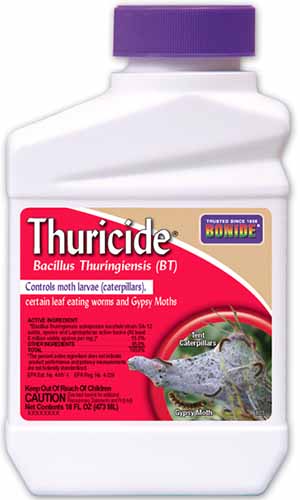
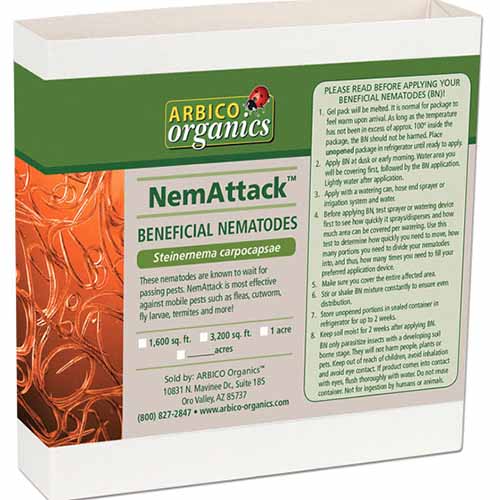
Do I have to go out and pick worms and eggs off every day? If that is what I have to do then I am not sure growing brussel sprouts are worth it. 😂
I hear you, Sarah! It can be a pain. If you do it every day, you can get the situation under control much quicker. I usually spend two solid weeks picking daily, and then I don’t have to deal with them at all after that. But you could do it less often or opt for chemical control.
Hi Sarah, Last year I started growing brussels. I made many mistakes, the main one being not covering them, so they were an ideal target for the cabbage white. This year I thought I would try and be smart and planted them under fine netting. I watched the frustration of the cabbage white moths trying to get to them. I have just taken the netting off on initial views the condition of the leaves and sprouts look good. I still have a problem in that as last year the brussels are not maturing from the bottom up. The brussels at… Read more »
Hi Mike, don’t worry, we all make mistakes. Netting is always a fantastic idea and yet I still sometimes skip it (and always regret it). With the white substance, photos would help me figure out the cause. It is just on the undersides or tops? Both? Near the stems or over the entire leaf surface? Typically, when something is eating the interior of the sprouts, we look to various caterpillars. The cabbage white worm would be my first guess, but you would see feeding on the leaves, as well. If the grit isn’t falling out of the dead center but… Read more »
Thanks for your response. I have taken off most of the leaves that had the white substance on and put in the council recycle bin. The deposit was mostly on the tops of the leaves. There were a few caterpillars trespassing across the plants and also slugs, both on the leaves and the brussels. I had treated the ground several times across the season. The brussels do have a lot of a black grit on, so your thoughts on aphids is likely. They also require several layers to be removed before cooking. That said there is seldom any damage on… Read more »
Hi Mike, it could very well be that you have both caterpillars and aphids, from the sound of it. Any leaves touching the nets are susceptible to feeding.
Rotating out sprouts for a year is a great idea. Pests can build up if the same plant grows in the same spot year after year. Best of luck!